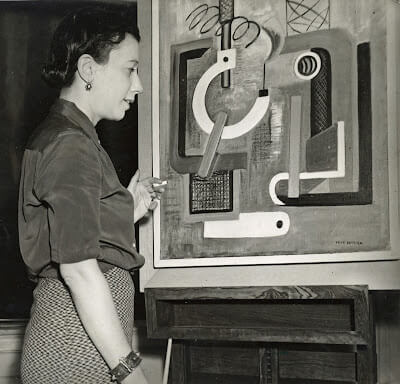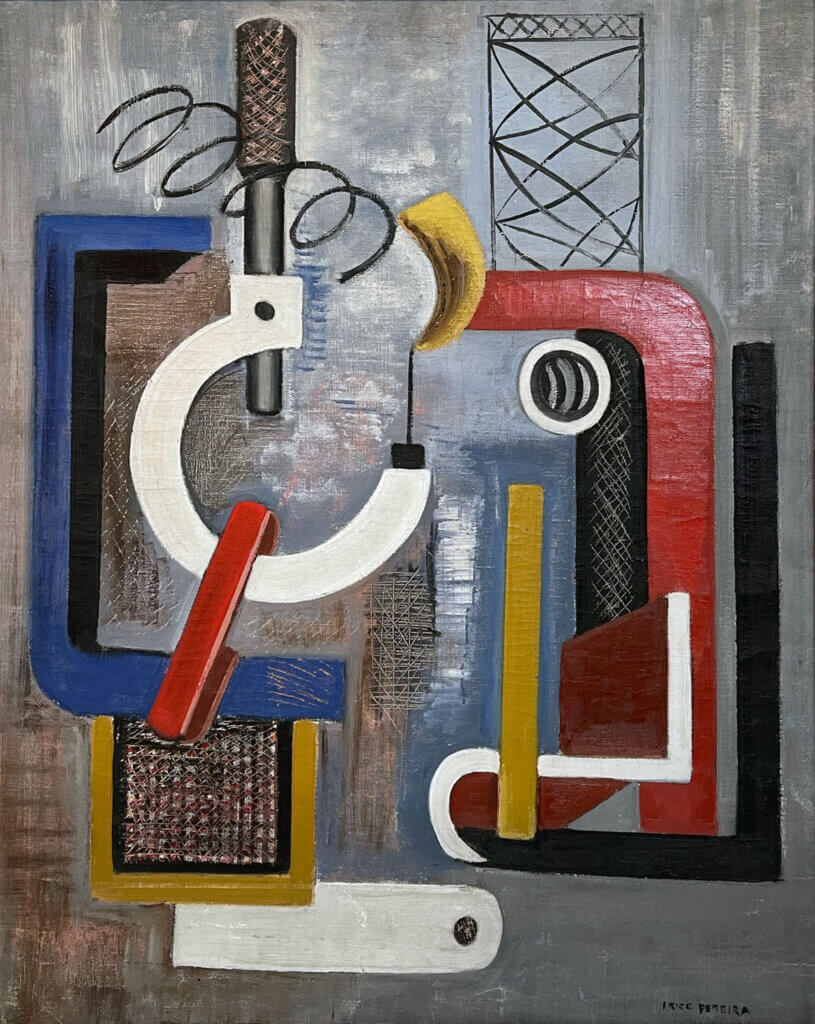BIOGRAPHY

Born Irene Rice, she took the name of her first husband, the commercial artist Umberto Pereira. She adopted the name I. Rice Pereira because then as now discrimination beset women in the arts. By the time war broke out Irene had divorced Pereira and married George Wellington Brown, a marine engineer from a prominent Boston family. Brown was an ingenious experimenter with materials, and he encouraged his petite new wife in their mutual passion for experimentation. Pereira in the 1930s was drawn to ships, not only because of George Brown, but because of their intricate machinery, their functional beauty. The inside-out infrastructure of the Pompidou museum in Paris amused Pereira, although she thought it art-historically tardy.
Pereira visited Morocco briefly in the mid-1930s. The desert changed her life, filling her mind with pure light and purer forms, and had a crucial impact on her work when she returned to the United States to help found the Works Progress Administration Design Laboratory. The interactions of light and shadow among the dunes, playing in and around the intrinsically Cubist architecture of the Magreb, instilled in her a lifelong concern with optics, the way the mind perceives light and interacts with paintings.
Irene Rice Pereira was a lovely, fragile being. Her presence was hushed. She spoke almost in a whisper and listened far more than she spoke. She was a prodigious autodidact and a spellbinding lecturer. The main body of her metaphysical library today resides in the Museum for Women in the Arts in Washington, D.C. Her papers and the manuscript for her still unpublished book, Eastward Journey, are available to scholars in the Schlesinger Library at Harvard.
 Pereira won recognition for her abstract geometric work, particularly her jewel-like works on fluted and coruscated layers of glass, throughout the 1940s and early 1950s. In 1953 the Whitney Museum, then in Greenwich Village, gave her a retrospective exhibition with Loren MacIver, and that same year Life magazine published a centerfold photo examination of her work.
Pereira won recognition for her abstract geometric work, particularly her jewel-like works on fluted and coruscated layers of glass, throughout the 1940s and early 1950s. In 1953 the Whitney Museum, then in Greenwich Village, gave her a retrospective exhibition with Loren MacIver, and that same year Life magazine published a centerfold photo examination of her work.
By the late 1950s Abstract Expressionism had swept Manhattan, flattening such nascent movements as Geometric Abstraction. Such artists as Stuart Davis, Stanton MacDonald Wright, George L.K. Morris, George Ault, Jan Matulka, Richard Leahy, Philip Guston and many others were eclipsed. Pereira believed that a European angst, brought to our shores in the wake of the Holocaust, had introduced a cynicism and a profoundly anti-female sensibility that boded ill for art in America. Rightly she pointed out that even when the works of women were acquired by museums they were rarely shown, a disgrace that persists to this day. The women who did achieve success, she said, were often collaborators with more famous male artists and tastemakers.
Pereira died in 1971 in Marbella, Spain, ill and broken-hearted. She had been evicted from the Fifteenth Street studio in Chelsea where she had painted for more than thirty years. Suffering from severe emphysema, she could barely negotiate a few stairs.
But by the 1980s a new generation of women scholars and curators had begun to resurrect her stature. A considerable following has formed to honor a pioneer artist who cared about other artists and willingly paid the price to denounce what others feared in silence. Indeed when Pereira sold a painting she had two immediate impulses: buy a new hat, and give the money to an artist friend in trouble. She loved hats but loved to help fellow artists even more.
GOOGLE SEARCH & Other Links:
https://www.encyclopedia.com/
https://americanart.si.edu/
https://www.dwigmore.com/
https://www.caldwellgallery.
